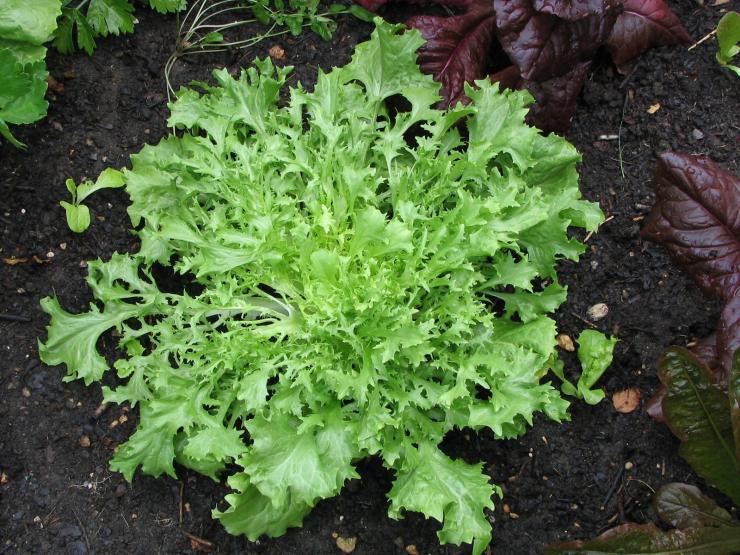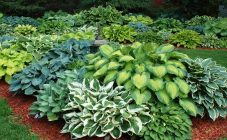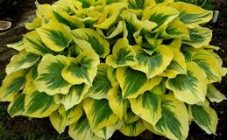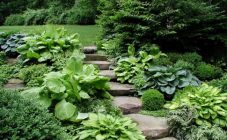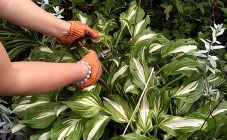Content:
Hosta (Latin Hosta) or funkiya is a representative of perennial herbaceous plants of the Asparagus family. Hosts are popular for landscape compositions and are highly valued for their shade tolerance and relative unpretentiousness.
To date, more than 600 varieties of these plants have been registered and new ones are bred every year in the course of breeding work. With such a variety, the existence of very similar subspecies is inevitable, which can only be distinguished upon closer examination.
Hosts: varieties and types
All variety of host varieties, depending on their growth, are conventionally divided into the following groups:
- Mini category - miniature hosts, whose height does not exceed 15 cm (Miniature);
- category D - dwarf hosts that do not even reach 10 cm in height (Dwarf);
- category S - small hosts, the height of which ranges between 15 and 25 cm (Small);
- category M - medium hosts (Medium, 25–45 cm);
- category L - large hosts, from 45 to 70 cm (Large);
- category G - giant hosts over 70 cm tall (Giant).
Miniature varieties include:
- Lakeside Little Tuft;
- Delia;
- Little Jim (Little Jim).
Dwarf hosts are:
- Blue Ice;
- Blue Moon;
- Sparky.
The category of small hosts includes varieties:
- Köhly Fries (Curly Fries);
- host Stiletto;
- Niagara Falls;
- Mighty Mouse (MightyMouse);
- Pizzazz;
- Raspberry Sundae;
- Luna Moth;
- Minuteman;
- Snake Eyes
- host Rainbows End.
Medium hosts include:
- host June (June);
- host Golden Tiara;
- host Brim Cap;
- Paradise Island;
- host Orange Marmalade (Orange Marmalade);
- host CherryBerry (CherryBerry);
- Christmas Three (ChristmasTree);
- host Carnival;
- Avocado (Avocado);
- Paul's Glory or Paul's Glory;
- August Moon;
- Moon Split (MoonSplit);
- Firn Line (FirnLine);
- Thunderbolt
- Sun Power (SunPower);
- Wolverine or Wolverine;
- El Niño (ElNino);
- Canadian Blue (CanadianBlue);
- Spartacus (HostaSpartacus);
- Tokudama Flavocircinalis (TokudamaFlavocircinalis);
- Yellow River (YellowRiver);
- Revolution (Revolution);
- Color Glory (ColorGlory);
- Allegan Fog (AlleganFog);
- Abiqua Drinking Gourd;
- Bullfrog;
- Beach Boy (Beach Boy);
- Francais (France);
- Restless Sea;
- Snow Cap (SnowCap);
- Patriot (Patriot);
- First Love (FirstLove);
- Warwick Comet
- Hanky punks (HankyPanky);
- host Blue Ivory;
- Pathfinder;
- Sunset Grooves;
- Ripple Effect (Ripple Effect);
- Magic Island (MagicIsland);
- Night Beefo Christmas (Night Before Christmas);
- Red Oktober (RedOctober);
- Lakeside Cupcake;
- Merlin Monroe (Marilyn Monroe);
- Lady Guinevere;
- Benverny (Ben Vernooij);
- Spilt Milk (Spilt Milk);
- Colored Hulk
- Fire Island;
- Love Pat;
- Gooseberry Sunday;
- Autumn Frost;
- Invisible (Invincible);
- Lakeside Banana Bay;
- Ghost Spirit;
- Paradise Joyce.
Large host varieties:
- host Kiwi Full Monty;
- host American Halo;
- Bressingham Blue or host Bressingham Blue;
- Twilight or Twilight;
- Aureomarginate;
- Saint Paul;
- Hosta Guacamole
- Atlantis;
- Regal Splendor;
- host Catherine;
- Robert Frost
- Cross Regal (KrossaRegal);
- Sharman (Sharmon);
- Eskimo Pie;
- Antioch;
- Neptune;
- Guardian Angel (Guardian Angel);
- ForbiddenFruit;
- Great Expectations;
- Christmas Candy (Christmas Candy);
- Sugar Daddy (SugarDaddy);
- Mata Hari (MataHari);
- Majesty;
- Blue Mammoth;
- Inniswood;
- Zounds;
- Brother Stephan (Brother Stephan);
- Summer Breeze (SummerBreeze);
- Dancing Queen (DancingQueen);
- Velvet Moon
- AbiquaMoonbeam;
- Paradigm (Paradigm);
- Delta Down (DeltaDawn).
The giant host group includes:
- Dream Queen;
- Saga (Saga);
- Empress Wu or Empress Wu;
- Big Daddy (BigDaddy);
- Blue Umbrellas;
- Sagae.
Description of popular hosta varieties
Among the most purchased varieties of host are primarily varieties, the leaves of which are colored in gray, bluish and other colors other than the traditional green. Varieties with various veins or spots are in particular demand.
The most popular varieties include the following:
- Thunderbolt (Thunderbolt) or Thunderbolt - a vigorous host with dense foliage. The leaf plates are painted in bluish tones, with a white stripe running in the center of the leaf, which turns yellow by the end of summer. It is a shade-loving plant that overwinters well in large containers. Bush height 50-60 cm, width - 70-80 cm. Preferred soil type: loose, drained, except dry sandy.
- First Frost is a medium-sized spreading variety of the “chameleon” group. He belongs to this group for the peculiarity of the leaves - during the season they change their color from gray to rich green. The name of the variety is translated as "First Morozets". Hosta is so named for the fact that it does not lose its attractive appearance until the first frost. Plant height reaches 50 cm, width - 60-90 cm. Leaves are oval, with a pointed tip and heart-shaped base, dense, gray-blue with a yellow border. The flowers are light purple. The plant prefers fertile, moist soils.
- hosta Sumand Substance is a giant hosta growing up to 1 m in diameter. This is the owner of huge leaves of a bright yellow-green color. The surface of the sheet plate is corrugated. The main advantage of Sam and Substens is its unattractiveness to pests, but this variety is quite picky about watering and regular feeding, unlike many others. Sam and Substance blooms with large pale lavender flowers with a rich sweet scent of lilies. The variety is very winter hardy.
- Captain's Adventure is a highly decorative host. The leaves are in the form of a small rosette, the color is yellow-green. The edges of the leaf plates are dark green. Capitance Adventure develops well in diffused lighting. Growth - 50–55 cm. Lavender flowers. Hosta changes shade depending on growing conditions. It is better to plant Captain Adventure on moderately moist soils.
- Hosta Lakeside Dragonfly is a moisture-loving compact variety with elongated bluish leaves. The edges of the leaves are bordered with a creamy stripe. This hosta blooms with small purple flowers. The variety grows strongly. Flower size: up to 8 cm. Plant height: up to 30 cm. The high winter hardiness of this hosta variety allows you to grow the plant in regions with severe winters without problems. Lakeside Dragonfly is planted in fertile, drained soils.
- Tee Rex (TRex) is a giant shade-tolerant host, blooming with large white flowers. The leaves of the variety are gray, corrugated. Plant height is more than 70 cm. In width the bush grows 180 cm, fully reaching varietal qualities for 4-5 seasons. The flowers are light lilac. Tee Rex prefers slightly acidic soils.
- So Sweet is a compact host with very fragrant flowers. A distinctive feature of the variety is the characteristic sharpness of the leaves, bordered by a light thin strip. The plant grows equally well both in the sun and in the shade, however, areas with an openwork shade are best suited for growing the Sow Sweet species, since in such conditions the bright color of the foliage is well manifested.
- Blue Ivory is an ornamental variety with bluish leaves surrounded by a creamy border around the edge. By the fall, this strip becomes snow-white. Blue Ivory is shade-loving and medium-sized (up to 50 cm in height). The leaf is thick. It develops well in the sun and in openwork shade. Prefers light, loose, moderately moist soils.
- hosta Liberty is a bright vigorous variety with dense foliage. Leaves are cordate, with a wide golden stripe along the edge. With age, the yellow edging fades to creamy white and expands, practically displacing the green color. The plant is light-requiring and does not tolerate shade. Flower size: up to 8 cm. Plant height: up to 1 m. The only drawback of this variety is its very slow growth.
- Little White Lines is a miniature host with white and green foliage. The variety is usually planted in small containers or pots. Plant width - up to 46 cm. Plant height: up to 20 cm.This variety needs to be divided every 3-4 years. Otherwise, it turns green and loses its decorative effect.
On the basic principles of agricultural technology
Even a beginner in floriculture will not be difficult to grow a host, as it is a rather unpretentious plant. It is not afraid of frost and does not need regular feeding, and also tolerates both drought and frost without any negative consequences.
Soil requirements
Khosta grows best on moderately moist soils enriched with humus. A neutral or slightly acidified soil is suitable. On sandy and loamy soils, plants do not take root well.
Landing in open ground
Hosta is usually planted in spring, at the end of April. It is better to do this when the threat of the last frost has passed. Can also be planted hosta in September.
Planting holes for the host are placed at a distance of 30-80 cm, depending on the variety. Strongly branched bushes are planted at a distance of 100 cm from each other. After planting, they are abundantly watered and mulched: for this you can use sawdust or bark.
Watering
It is very important to water the hosts on time, as the soil around them should be slightly moist all the time. It is better to do this in the morning or in the afternoon, but in cloudy weather, since watering in midday light can provoke leaf burns.
Preparing for winter
In September, host preparations for wintering begin. For this, almost the entire ground part of the plant is cut off in order to get rid of possible pests that often hide in the foliage. There is no need to cover the plants additionally, but you can mulch them for better wintering.
Diseases and pests
Hosts are considered one of the most hardy perennials, however, they are sometimes affected by diseases and pests. Most often, plants are damaged by snails and slugs, which can be easily detected by the presence of whitish marks on the leaves. Varieties with a thin leaf blade, as well as leaves that grow close to the soil, are especially vulnerable to these pests. Granular baits will help to protect the plants.
Of the diseases, the most dangerous for the host is phyllostictosis. The first sign of this fungal disease is the appearance of yellowish-brown spots on the leaves and peduncles of plants. Soon after infection, the damaged tissue begins to dry out, which leads to the early death of the hosts.
Host variety allows you to choose a plant for almost every taste. They can be grown outdoors or kept at home. Depending on the variety, the plants are planted in the shade, partial shade or in the sun. Finally, due to the variety of shapes and colors, they can be used when organizing a wide variety of landscape compositions - flower beds, ridges and borders. Large plants look great in single planting.









